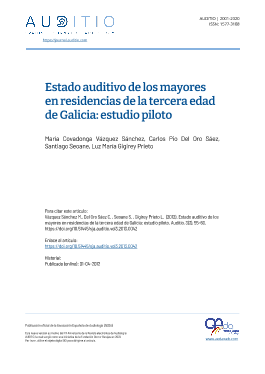Estado auditivo de los mayores en residencias de la tercera edad de Galicia: estudio piloto
DOI:
https://doi.org/10.51445/sja.auditio.vol3.2013.0042Palabras clave:
pérdida de audición, déficit auditivo, screening auditivo, mayores, envejecimientoResumen
Diversos estudios ponen de manifi esto la estrecha relación entre envejecimiento y descenso de la sensibilidad auditiva. Galicia ocupa el tercer lugar en el ranking de regiones españolas con mayor porcentaje (21.6%) de personas de edad (65 o más años) y es la comunidad autónoma que pierde población más rápidamente. A su vez, en nuestra comunidad existe un elevado porcentaje de personas de edad que refi eren problemas de audición (INEBase, 2010). Sin embargo, a pesar de esta evidencia estadística, no se ha realizado hasta la fecha ningún estudio audiológico. Objetivo: Establecer, a través de un programa piloto de screening desarrollado en Centros Gallegos de la Tercera Edad, las bases audiológicas que permitan caracterizar el estado auditivo de la población gallega mayor. Método: Evaluamos 402 sujetos (≥ 60 años). El protocolo audiológico consistió en una otoscopia, seguida de una Audiometría Tonal Liminar y el Test del Susurro. El diagnóstico de daño auditivo se realizó en base al criterio internacional de Ventry y Weinstein. Resultados: El 58% de los residentes presenta hipoacusia, siendo mayor su prevalencia en los varones (63,9% versus 54.7%). Encontramos diferencias signifi cativas en los umbrales promedio (p<0,05) y en la HFPTA(1-4KHz) (p< 0,05) entre géneros, así como en función de la edad. Conclusión: Considerando el cambio demográfi co que experimenta la sociedad gallega, nuestros resultados sitúan a la pérdida de audición entre los principales problemas de salud pública del futuro.
Descargas
Visibility and Altmetrics
Métricas
Citas
Agrawal Y, Platz EA, Niparko JK. Prevalence of hearing loss and differences by demographic characteristics among US adults. Arch Intern Med. 2008 Jul 28;168(14):1522-30 https://doi.org/10.1001/archinte.168.14.1522
Australian Hearing Annual Report 2009 [consultado en Febrero de 2011] Disponible en http://www.hearing.com/anual-reports
Brant L, Fozard J. Age changes in pure-tone hearing thresholds in a longitudinal study of normal human aging. J Acoust Soc Am. 1990 Aug; 88(2):813-20. https://doi.org/10.1121/1.399731
Bech B, Chistensen B, Parving A. The Valby Project. A survey of the hearing in the elderly >80 years of age provided with hearing aids. Scand Audiol. 1996; 25(4):247-52. https://doi.org/10.3109/01050399609074962
Catalán CE, Abellán A (2008). "Encuesta de Discapacidad, Auto-nomía personal y situaciones de Dependencia (EDAD 2008). Primeros resultados". Madrid, Portal Mayores, Informes Portal Mayores, nº87. [Fecha de publicación: 13/11/2008]. Disponible en http:// www.imsersomayores.csic.es/documentacion/estudiosyresultados/ informes/index.html.
Challengers for the 21st century. Chronic and disabling conditions. Number 2. National Academy on an aging Society. December 1999. Disponible en http://www.agingsociety.org
Clark JG. Uses and abuses of hearing loss classifi cation. ASHA.1981 Jul;23(7):493-500.
Cooper J. Health and Nutrition Examination Survey of 1971- 75. Part I: Ear and race effects in hearing. J Am Acad Audiol. 1994 Jan;5(1):30-6. .
Cruickshanks KJ, Wiley TL, Tweed TS, Klein BE, Klein R, Mares- Perlman JA, Nondahl DM. Prevalence of hearing loss in older adults in Beaver Dam, Wisconsin. The Epidemiology of Hearing Loss Study. Am J Epidemiol. 1998 Nov 1; 148(9):879-86. https://doi.org/10.1093/oxfordjournals.aje.a009713
Davis AC. The prevalence of hearing impairment and reported hearing disability among adults in Great Britain. Int J Epidemiol. 1989 Dec; 18(4):911-7. https://doi.org/10.1093/ije/18.4.911
Davis A. Prevalence of hearing impairment. En: Hearing in adults, chapter 3. London: Whurr Ltd, 1995; 46-45.
Eurostat, EUROPOP2008 Regional population projections. Euro- Geographics Association, for the administrative boundaries Cartography: Eurostat - GISCO. [Fecha de publicación: 1/2009]. Disponible en http://ec.europa.eu/eurostat
Gates G, Cooper J, Kannel W, Miller N. Hearing in the elderly: The Framingham Cohort, 1983-1985.Part I: Basic audiometric test results. Ear Hear. 1990 Aug;11(4):247-56 https://doi.org/10.1097/00003446-199008000-00001
Hull R. Hearing in Aging. San Diego: Singular Publishing Group. 1995
Instituto Nacional de Estadística. INEbase [Sitio web] [consultado en Noviembre de 2010].Disponible en http://www.ine.es
Jerger J, Chmiel R, Wilson N, Luchi R. Hearing impairment in older adults: new concepts. J Am Geriatr Soc. 1995 Aug; 43(8): 928-35. https://doi.org/10.1111/j.1532-5415.1995.tb05539.x
Jönsson R, Rosenhall U. Hearing in advanced age. A study of presbyacusis in 85-, 88- and 90-year-old people. Audiology. 1998 Jul- Aug;37(4):207-18 https://doi.org/10.3109/00206099809072975
Karlsmose B, Lauritzen T, Parvin A. Prevalence of hearing impairment and subjective hearing problems a rural Danish population aged 31-50 years. Br J Audiol. 1999 Dec;33(6):395-402. https://doi.org/10.3109/03005364000000107
Karlsson Espmark AK, Hanson Scherman M. Hearing confi rms existence and identity-experiences from persons with presbyacusis. Int J Audiol. 2003 Mar;42(2):106-15 https://doi.org/10.3109/14992020309078341
Las Personas Mayores en España. Informe de 2008. Tomo I. Ministerio de Sanidad y Política Social. Secretaría General de Política Social. IMSERSO. 2009. [Consulta en Febrero de 2011]. Disponible en http://www.imsersomayores.csic.es
Laukli E, Molde B, Solem BS, Stenklev NC. Hearing in the elderly: a test protocol and preliminary results. Scand Audiol Suppl. 2001;(52):167-70. https://doi.org/10.1080/010503901300007425
Mäki-Torkko EM, Brorsson B, Davis A, Mair LWS, Myhre KL, Roine RP et al. Hearing impairment among adults-extent of the problem and scientifi c evidence on the outcome of hearing aid rehabilitation. Scand Audiol Suppl. 2001;(54):8-15. Review. https://doi.org/10.1080/010503901750409385
Mościcki EK, Elkins EF, Baum HM, McNamara PM. Hearing loss in the elderly: An epidemiologic study of the Framingham Heart Study Cohort. Ear Hear. 1985 Jul-Aug;6(4):184-90. https://doi.org/10.1097/00003446-198507000-00003
Mulrow CD, Aguilar C, Endicott JE, Tuley MR, Velez R, Charlip WS et al. Quality-of-life changes and hearing impairment. A randomized trial. Ann Intern Med. 1990 Aug 1;113(3):188-94. https://doi.org/10.7326/0003-4819-113-3-188
Mulrow CD, Aguilar C, Endicott JE, Velez R, Tuley MR, Charlip WS et al. Association between hearing impairment and the quality of life of elderly individuals. J Am Geriatr Soc. 1990 Jan;38(1):45-50. https://doi.org/10.1111/j.1532-5415.1990.tb01595.x
National Institute of Deafness and Other Communication Disorders 2009. Quick Statistics.[Sitio web] [consultado el 6 de Marzo de 2009]. Disponible en http://www http://www.nided.uih.gov/health/ statisitcs/hearing.asp
Pearson JD, Morrell CH, Gordon-Salant S, Brant LJ, Metter EJ, Klein LL et al. Gender differences in a longitudinal study of ageassociated hearing loss. J Acoust Soc Am. 1995 Feb; 97(2):1196-205. https://doi.org/10.1121/1.412231
Pirozzo S, Papinczak T, Glasziou P. Whispered voice test for screening for hearing impairment in adults and children: systematic review. BMJ. 2003 Oct 25;327(7421):967. Review. https://doi.org/10.1136/bmj.327.7421.967
Pleis JR, Lethbridge-Cejku M. Summary health statistics for U.S. adults: National Health Interview Survey, 2006. Vital Health Stat 10. 2007 Dec;(235):1-153. https://doi.org/10.1037/e403882008-001
Radcliffe D. Is hearing loss increasing at younger ages? Many think so, but it's hard to prove. The Hearing Journal .2000 May; 53(5):23-24, 26-29. https://doi.org/10.1097/00025572-200005000-00003
Rosenhall U, Pedersen K, Moller MB. Self-Assessment of hearing problems in a elderly population. A longitudinal study. Scand Audiol. 1987;16(4):211-7 https://doi.org/10.3109/01050398709074943
Rosenhall U, Jönsson R; Söderlind O. Self-Assessed hearing problems in Sweden: a demographic study. Audiology 1999 Nov- Dec;38(6):328-34 https://doi.org/10.3109/00206099909073044
Schow R & Nerbonne M. Hearing levels among nursing-homes residents. J Speech Hear Disord. 1980 Feb;45(1):124-32. https://doi.org/10.1044/jshd.4501.124
Ulf Rosenhall, Ann-Kristin Karlsson Espmark. Hearing aid rehabilitation: what do older people want, and what does the audiogram tell? Int J Audiol. 2003 Jul;42 Suppl 2:2S53-7. https://doi.org/10.3109/14992020309074644
Uimonen S, Mäki-Torkko E, Jounio-Ervasti K, Sorri M. Hearing in 55 to 75 year old people in northern Finland - a comparison of two classifi cations of hearing impairment. Acta Otolaryngol Suppl. 1997;529:69-70. https://doi.org/10.3109/00016489709124084
Weinstein BE, Ventry IM. Audiometric correlates of the Hearing Handicap Inventory for the elderly. J Speech Hear Disord. 1983 Nov;48(4):379-84. https://doi.org/10.1044/jshd.4804.379
Weinstein BE. Geriatric Audiology. New York: Thieme Medical Publishers,Inc ; 2000.
WHO/DIMDI. [Sitio Web]. International Statistical Classifi cation of Diseases and Related Health Problems. 10th version World Health Organization. 1994/2006 [consultado en Diciembre de 2010] Disponible en http://apps.who.int/classifi cations/apps/icd/icd10online

Publicado
Versiones
- 2021-09-15 (2)
- 2012-04-01 (1)
Cómo citar
Número
Sección
Licencia
Derechos de autor 2012 Asociación Española de Audiología

Esta obra está bajo una licencia Creative Commons Reconocimiento 3.0 Unported.
Artículos publicados después de 2020
Los autores retienen el copyright y dan permiso y derecho a la revista para publicar su primera publicación bajo licencia, si no se expresa lo contrario. Creative Commons Attribution License la cual permite a otros el compartir siempre que se de reconocimiento a los autores de la publicación en esta revista. Si los autores deseasen aplicar ciertas restricciones en su permiso para usos no comerciales u obras derivadas, éstos podrán elegir entre las siguientes licencias:
https://creativecommons.org/about/cclicenses/
Publicaciones 2001-2020
Los textos publicados en esta revista en la seccion de "AUDITIO 2001-2020 están sujetos –si no se indica lo contrario– a una licencia de Reconocimiento 3.0 España de Creative Commons. Puede copiarlos, distribuirlos, comunicarlos públicamente, hacer obras derivadas y usos comerciales siempre que reconozca los créditos de las obras (autoría, nombre de la revista, institución editora) de la manera especificada por los autores o por la revista. La licencia completa se puede consultar en http://creativecommons.org/licenses/by/3.0/es/deed.es.








 AUDITIO | Spanish Journal of Audiology
AUDITIO | Spanish Journal of Audiology
